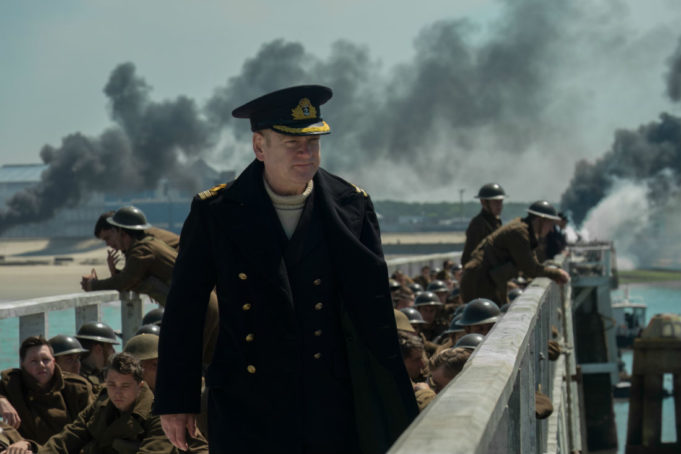Maybe I’m just fated to go through life admiring Christopher Nolan’s movies more than I like them. Good thing I admire them a hell of a lot. His latest film, Dunkirk is the first film fully about the retreat that effectively saved the British war effort during World War II. You might think that conflict was exhausted as a subject, but Dunkirk has been left untouched by most films because a) it took place before America’s involvement in the war, leaving fewer opportunities for American audiences to become invested in the story and b) it was a military defeat, albeit one that galvanized the British public because it could have been much worse. A couple of films have referred to the evacuation, notably Joe Wright’s Atonement, whose famous tracking shot took place there, and Their Finest from this past spring, a charming film about a group of British filmmakers trying to make a movie about Dunkirk. Nolan’s account of the battle may not be worthy of the critical hosannas being directed its way, but it does get the job done.
If you’re unfamiliar with the Battle of Dunkirk, here’s my amateur military history. In 1940, the British army had been sent to the European continent to defend France against the Germans. They expected to meet the Germans head on in the Netherlands, but the enemy took an unexpected route and flanked the Allied troops, leaving some 400,000 men pinned up against the sea on the Franco-Belgian border. Without any cover, the soldiers were completely exposed to Luftwaffe planes. The British military offered precious little help, holding back most of their ships and planes for an anticipated full-scale Nazi invasion of Britain. The country’s civilian population wound up having to save the army, as hundreds of boat owners responded to a military requisition and made the 50-mile or so journey across the English Channel to carry the men back home. London was expecting less than 10% of its soldiers to return, and instead some 80% wound up coming back.
Nolan gives us the story via fictionalized characters in three overlapping timelines. One takes place over the course of an hour, as two RAF pilots named Farrier and Collins (Tom Hardy and Jack Lowden) try to keep German fighters and bombers off the guys on the beach. A second one takes up a day, as a boat owner named Dawson (Mark Rylance) takes out his unarmed pleasure boat with his teenage son (Tom Glynn-Carney) and heads into the fighting to ferry back as many men as he can take. The third is set during the whole hellish week of the evacuation, as a British private named Tommy (Fionn Whitehead) does his damnedest not to die amid the bombings and strafings, while a naval commander (Kenneth Branagh) grimly tries to direct the proceedings as best he can from his spot on the edge of a pier.
I’m not sure why Nolan has structured his movie in this way. Like most of his other films, this one practically begs the viewer to re-edit it into a conventional, linear timeline to see if it will work any better. Nolan presents us with one British sailor (Cillian Murphy) coolly helping with the retreat before cutting back to that same sailor as a shivering wreck plucked off a torpedoed ship, panicking and screaming at Dawson to turn his boat back to England. The temporal dislocation doesn’t relate to the chaos of the war, nor does it increase the forward drive of the story. Since he’s the first filmmaker to tell this story, Nolan might have been better served by a more straightforward approach.
Nolan does better at the small-picture level. The film is rated PG-13, as Nolan wisely declines to challenge Steven Spielberg when it comes to depicting the confusion and bloody brutality of war. Despite that, he manages to convey the cold logic of Tommy’s flight from the enemy; every time he thinks he’s secured his passage back home, he gets a boat sunk from under him. The movie opens with him being the only survivor, as a group of fellow soldiers are taken out by German machine guns as they flee through the town of Dunkirk. At one point, he swims frantically toward a naval destroyer, only to have to swim in the other direction when the ship is hit by bombs and his rescuers suddenly need to be rescued themselves. The scenes of aerial combat, too, are captured in their analog glory, as Farrier’s plane takes a bullet that knocks out the fuel gauge, and he’s forced to track his gasoline by scrawling numbers on his instrument panel in chalk while looking at his watch. There’s great intensity in the sequence with Collins ditching his wounded plane safely in the ocean, only to find himself trapped in a cockpit that’s filling up with water. See this in the IMAX format and the bombs landing near the soldiers will shake the floorboards, and the sound comes through with such clarity that you can feel the shock from Farrier’s bullets hitting an enemy plane, just as the pilot can.
The writer-director is too busy charting everybody’s movements to include much in the way of characterization, though it does spare us the template that we tend to get in such films where combatants are given one trait. The cast is too good to come away empty-handed, with Rylance beautifully projecting calm determination and Branagh efficiently barking out orders while bombs fall around him. One Direction member Harry Styles blends seamlessly into the ensemble as a soldier who accompanies Tommy and whose actions during the siege land somewhere between noble and shameful.
All told, Dunkirk may not have the crushing impact of Saving Private Ryan or A Very Long Engagement (a World War I film, but a useful comparison), and its visual of all those English boats sailing over the horizon to save the soldiers isn’t as overwhelming as it would like. Even so, this is an account of a neglected chapter of history that does justice to its scope, thanks to Nolan’s assiduous application of his craft.
Dunkirk
Starring Fionn Whitehead, Tom Hardy, Mark Rylance, and Kenneth Branagh. Written and directed by Christopher Nolan. Rated PG-13.













It’s amazing how hype, a vastly overrated reputation, and a jackhammer sound score can mesmerize some naive souls into believing this wretched exercise is some kind of masterpiece of avant-garde filmmaking. If Saving Private Ryan rates A+, Dunkirk rates a D–.
On every conceivable level it fails: characterization (NONE). Editing: a totally haphazard stitching of action sequences, with no suspense. The constant buzzsaw sound track is supposed to compensate for this fault, but it is just annoying. Dark, cloudy, poorly focused photography. Continuity problems. Bad, mumbling, intelligible dialogue. Implasubile, ridiculous motivation (the private boat where the mutinous soldier kills a crew member — with no reaction from the others). Reptititious, redundant scenes (Spitifires ditching twice, attacking the Heinkel over and over).
Perhaps worst of all is how he bungled the dramatic rescue by a flotilla of private boaters — the core of this story. We could have had Churchill’s appeal, the humble yeomen assembling on the docks with a mixture of trepidation and courage — instead, the boats suddenly appear all at once, deus ex machina, at the beaches, with no depiction of the rescue at all.
Some critics need to make a distinction between successful non-traditional, non-linear filmmaking, and simple, hamfisted amateurish montage. I pity the poor souls who miscontrue Dolan’s efforts as some kind of daring Orson Wells/Maya Derren innovation, but there’s no accounting for masochism.
Couldn’t agree with you more, Travis. Was incredibly disappointed with this movie across all dimensions, given the hype. Seems like reviewers like Lin are just enamored by certain directors like Nolan, irrespective of the quality of work, or lack, thereof.